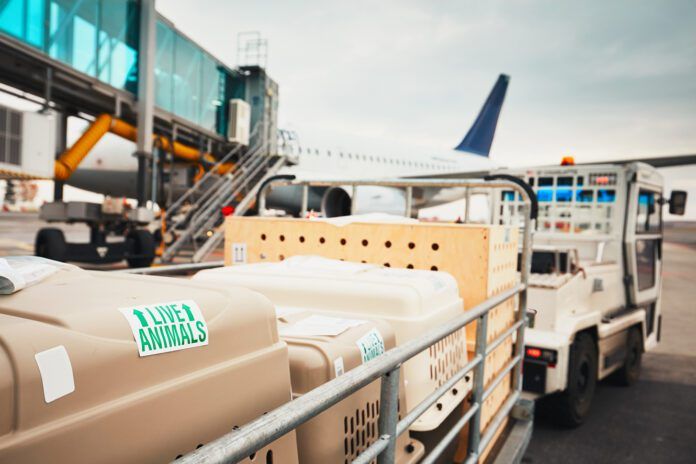
Statistically, it’s safer to fly than drive across the country, so if you have a long-distance journey to make with your dog and want to save time, you may decide to book a flight for the two of you. Here’s what you need to know when it comes to how to fly with your dog.
How to Fly With a Dog in the Cabin
If your dog is small enough to fit in a carrier under the seat in front of you, he can usually accompany you in the cabin as your carry-on item. You’ll need to notify the airline that you’ll be traveling with a pet—check the pet policy for the specific airline you’ll be flying as they vary between carriers. Also, you’ll be charged a pet fee, which typically costs $100 to $200 each way. Book the flight and make these arrangements early, as most flights will accommodate only a few pets in the cabin.
Be aware that there is no cut-and-dried rule regarding the size of dogs who can be carried on a plane. Most accurately, the limiting factor for which dogs can be carried onto a flight is the size of the dog’s carrier, and how well the dog appears to fit inside it. Every airline has different maximum dimensions for carriers—and airlines sometimes have different maximum dimensions for the various types of airplane that may be employed on your journey. Confirm that your carrier meets the airline’s requirements for under-seat pet carriers for all legs of your trip.
The airline will have other rules and regulations regarding vaccines, a health certificate from a veterinarian, and other paperwork for your dog. Read the rules carefully and get all your ducks (dogs!) in a row well in advance; health certificates can’t be prepared too far in advance of travel, so you’ll need to schedule a vet visit within a certain timeframe before your trip.

On your travel day, allow plenty of time to check in with your pet. In some cases, you’ll need to drive your pet to a special cargo area first, and then proceed to the passenger terminal to check in yourself. Make sure to have all required paperwork ready and accessible.
In addition to guidance you’ll receive from the airline, air-travel-savvy dog owners we spoke with recommended the following:
- Consider your dog’s temperament. Air travel can be stressful for humans, and we understand what’s going on! If your dog struggles with “stranger danger,” is sensitive to unknown sounds, or is generally fearful and anxious, we’d recommend flying the dog only if no other options exist.
- As with car travel – and just plain old common sense – make sure your dog has current identification and a working microchip registered with your current information.
Should You Medicate Your Dog Before Flying In the Cabin?
Do not sedate your dog prior to air travel. Sedatives can affect heart rate and respiration and can throw off a dog’s equilibrium. Also, most airlines will not accept a pet that has been knowingly sedated.
How to Fly With Your Dog as Cargo
If your dog does not meet the in-cabin size requirements and is not a task-trained service dog, he’ll need to travel in the cargo hold. Live animals flown as cargo are loaded into a pressurized and temperature-controlled area.
Not all planes are designed to transport live animals and space is limited. In addition, different airlines have different policies and restrictions for how larger pets are transported. For example, in the United States, Alaska Airlines will transport larger dogs as “luggage” (in the temperature-controlled section of the cargo hold) for $150 each way. American Airlines accepts checked pets only for active U.S. military—all other large dogs must be transported through American Airlines Cargo, which is considerably more expensive—often more than the cost of the human’s ticket. United Airlines also no longer transports pets that don’t meet in-cabin travel requirements unless the passenger is traveling as active-duty military or with the State Department.

Once you’ve made the decision to ship your dog as cargo, prepare for the big day with these tips:
- Triple-check crate regulations well in advance of travel. Airlines often require that dogs fly in crates that are large enough for dogs to stand up and turn around comfortably. Make sure your dog is very calm and comfortable in a crate long before he’ll need to fly in one.
- Bring nylon cable ties to further secure the door of the crate after airline personnel have inspected the dog and crate. Many airlines do this anyway, but if not, it’s good to be prepared.
- Airlines require crates to have a food and water dish attached on the inside of the crate. Freezing water in the dish makes it more likely your dog will be able to enjoy hydration during the flight, rather than having most or all of the water spilled in transport.
- Airlines require that you have “LIVE ANIMAL” and “THIS END UP” stickers and the dog’s and/or owner’s itinerary/s affixed to the dog’s crate. Consider adding some additional stickers or photos to make your dog’s crate easier to spot if you’re watching from the airport or airplane window. Fun decorations or amusing information about your dog are also likely to put a smile on the faces of the ground crew transporting your pet. If something about your dog makes them smile, they might be more likely to go the extra mile while he is in their care.
- Remind the gate agent that you’re traveling with a pet in cargo and ask to see your dog loaded into the plane. Consider including a cute photo of your dog and a $5 Starbucks gift card as part of your “ask” to encourage cooperation!
- If you can’t personally see your dog loaded into the plane, ask flight crew to radio ground crew for confirmation. Again, it never hurts to pair your request with a cute photo and a gift card.
The Importance of Early Planning When Flying With a Dog
In short, you’ll want to do your research ahead of time and plan carefully. Things can get tricky, especially when you’re trying to coordinate a significant relocation of your own. If the rules, regulations, and challenges related to flying your dog leaves your head spinning, consider working with a reputable pet relocation company whose employees are well-versed in the ins and outs of pet transport, and who can take charge of helping you safely get your four-legged friend from Point A to Point B as part of your move. Visit the International Pet and Animal Transportation Association for more information about working with a pet relocation company.
And if you decide that flying is too dicey, see “Driving Long-Distance With Your Dog” for tips on safe car travel with your canine companion.
For further information on how to fly with your dog internationally, see “Traveling Internationally With Your Dog”
Under the federal Air Carrier Access Act, service dogs (dogs trained to perform tasks to assist a qualified individual with a disability), regardless of size, may travel in-cabin with their disabled handlers, free of charge. In contrast, emotional support animals (ESAs) whose primary function is to provide emotional support, comfort, or companionship via their presence—as opposed to performing specific trained tasks that mitigate a disability—are no longer covered under the Air Carrier Access Act and must travel as pets. Airlines are not required to accommodate ESAs.





